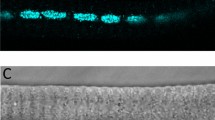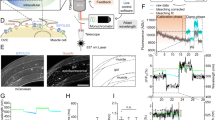Abstract
Changes in cytosolic calcium ion concentration ([Ca2+]i) have been implicated in a wide variety of cellular stimulus–transduction roles1–3. In nerve cells, it is believed that electrical activity raises [Ca2+]i, by allowing influx of Ca2+ through voltage-dependent channels in the surface membrane4,5. Elevation of neuronal [Ca2+]i may also occur due to release of Ca2+ from intracellular storage sites6–8. Transient increases in [Ca2+]i are thought to trigger neurotransmitter release9, and to modulate axonal transport10, energy metabolism11 and growth cone movement12. Intracellular Ca2+ also appears to regulate membrane potassium channels and thereby to regulate electrical excitability13. Although [Ca2+]i transients have been measured in a few giant invertebrate neurones14, detection of such transients in a vertebrate neurone has not been previously reported. We have measured [Ca2+]i in bullfrog sympathetic neurones by photometry of a microinjected calcium indicator dye, arsenazo III (refs 14–16), and report here that action potentials and voltage-clamped depolarizations cause long-lasting increases in [Ca2+]i. Also, exposure to the drug theophylline can cause spontaneous periodic increases in [Ca2+]i. Comparisons of [Ca2+]i signals with simultaneous intracellular recordings of membrane potential suggest that the kinetics of the post-tetanic hyperpolarization (PTH) following a series of action potentials or the spontaneous hyperpolarizations induced by theophylline directly reflect the kinetics of the [Ca2+]i, transient.
This is a preview of subscription content, access via your institution
Access options
Subscribe to this journal
Receive 51 print issues and online access
$199.00 per year
only $3.90 per issue
Buy this article
- Purchase on Springer Link
- Instant access to full article PDF
Prices may be subject to local taxes which are calculated during checkout
Similar content being viewed by others
References
Cheung, W. Y. Science 207, 19–27 (1980).
Watterson, D. M. & Vincenzi, F. F. Ann. N.Y. Acad. Sci. 356 (1980).
Kretsinger, R. H. Neurosci. Res. Prog. Bull. 19, 215–328 (1981).
Baker, P. F. Prog. Biophys. molec. Biol. 24, 177–223 (1972).
Hagiwara, S. & Byerly, L. A. Rev. Neurosci. 4, 69–125 (1981).
Henkart, M. Fedn Proc. 39, 2783–2789 (1980).
McCort, S. M. & Weight, F. F. Soc. Neurosci. Abstr. 5, 47 (1979).
Kuba, K. J. Physiol., Lond. 298, 251–269 (1980).
Katz, B. The Release of Neural Transmitter Substance (Liverpool University Press, 1960).
Ochs, S. Neurosci. Res. Prog. Bull. 20, 19–31 (1981).
Landowne, D. & Ritchie, J. M. J. Physiol., Lond. 212, 503–517 (1971).
Anglister, L., Sharar, A., Farber, I. C. & Grinwald, A. Soc. Neurosci. Abstr. 7, 548 (1981).
Meech, R. W. A. Rev. Biophys. Bioengng 7, 1–18 (1978).
Blinks, J. R., Wier, W. G., Hess, P. & Prendergast, F. G. Prog. Biophys. molec. Biol. 40, 1–114 (1982).
Budesinsky, B. in Chelates in Analytical Chemistry Vol. 2 (eds Flaschka, H. A. & Banard, A. J.) 1–19 (Dekker, New York, 1969).
Brown, J. E. et al. Biophys. J. 15, 1155–1160 (1975).
Minota, S. Jap. J. Physiol. 24, 501–512 (1974).
Busis, N. A. & Weight, F. F. Nature 263, 434–436 (1976).
Adams, P. R. Adv. physiol. Sci. 4, 135–138 (1981).
Kuba, K. & Nishi, S. J. Neurophysiol. 39, 547–563 (1976).
Crank, J. The Mathematics of Diffusion. (Clarendon, Oxford, 1975).
Gorman, A. L. F. & Thomas, M. V. J. Physiol., Lond. 308, 259–285 (1980).
Brinley, F. J. Jr A. Rev. Biophys. Bioengng 7, 363–392 (1978).
Gorman, A. L. F. & Thomas, M. V. Physiol., Lond. 275, 357–376 (1978).
Rios, E. & Schneider, M. F. Biophys. J. 36, 607–622 (1981).
Ahmed, Z. & Connor, J. A. J. Physiol., Lond. 286, 61–82 (1979).
Beeler, T. J., Schibeci, A. & Martonosi, A. Biochim. biphys. Acta. 629, 317–327 (1980).
Levy, S., Tillotson, D. & Gorman, A. L. F. Biophys. J. 37, 182a (1982).
Smith, S. J. & Zucker, R. S. J. Physiol., Lond. 300, 167–196 (1980).
MacDermott, A. B., Connor, E. A., Dionne, V. E. & Parsons, R. L. J. gen. Physiol. 75, 39–60 (1980).
Author information
Authors and Affiliations
Rights and permissions
About this article
Cite this article
Smith, S., MacDermott, A. & Weight, F. Detection of intracellular Ca2+ transients in sympathetic neurones using arsenazo III. Nature 304, 350–352 (1983). https://doi.org/10.1038/304350a0
Received:
Accepted:
Issue Date:
DOI: https://doi.org/10.1038/304350a0
This article is cited by
-
Muscles express motor patterns of non-innervating neural networks by filtering broad-band input
Nature Neuroscience (2000)
-
Investigation of the role of intracellular Ca2+ stores in generation of the muscarinic agonist‐induced slow afterdepolarization (sADP) in guinea‐pig olfactory cortical neurones in vitro
British Journal of Pharmacology (2000)
-
Characterization of calcium accumulation in the brain of rats administered orally calcium: The significance of energy-dependent mechanism
Molecular and Cellular Biochemistry (1996)
-
Independent regulation of calcium revealed by imaging dendritic spines
Nature (1991)
-
The inhibitory action of caffeine on calcium currents in isolated intestinal smooth muscle cells
Pfl�gers Archiv European Journal of Physiology (1991)
Comments
By submitting a comment you agree to abide by our Terms and Community Guidelines. If you find something abusive or that does not comply with our terms or guidelines please flag it as inappropriate.



